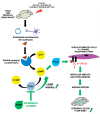Sildenafil-Mediated Neuroprotection from Adult to Neonatal Brain Injury: Evidence, Mechanisms, and Future Translation
- PMID: 34685745
- PMCID: PMC8534574
- DOI: 10.3390/cells10102766
Sildenafil-Mediated Neuroprotection from Adult to Neonatal Brain Injury: Evidence, Mechanisms, and Future Translation
Abstract
Cerebral stroke, traumatic brain injury, and hypoxic ischemic encephalopathy are among the most frequently occurring brain injuries. A complex pathogenesis, characterized by a synergistic interaction between alterations of the cerebrovascular system, cell death, and inflammation, is at the basis of the brain damage that leads to behavioral and neurodevelopmental disabilities in affected subjects. Sildenafil is a selective inhibitor of the enzyme phosphodiesterase 5 (PDE5) that is able to cross the blood-brain barrier. Preclinical data suggest that sildenafil may be a good candidate for the prevention or repair of brain injury in both adults and neonates. The aim of this review is to summarize the evidence supporting the neuroprotective action of sildenafil and discuss the possible benefits of the association of sildenafil with current therapeutic strategies.
Keywords: brain injury; neuroprotection; sildenafil.
Conflict of interest statement
The authors declare no conflict of interest.
Figures


References
-
- James S.L., Theadom A., Ellenbogen R.G., Bannick M.S., Montjoy-Venning W., Lucchesi L.R., Abbasi N., Abdulkader R., Abraha H.N., Adsuar J.C., et al. Global, regional, and national burden of traumatic brain injury and spinal cord injury, 1990–2016: A systematic analysis for the Global Burden of Disease Study 2016. Lancet Neurol. 2019;18:56–87. doi: 10.1016/S1474-4422(18)30415-0. - DOI - PMC - PubMed
Publication types
MeSH terms
Substances
LinkOut - more resources
Full Text Sources

